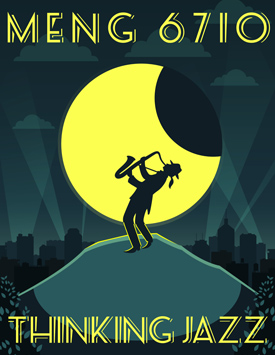
Thinking Jazz / The Literature and Culture of the Jazz Age
Fall
2015
Mondays, 5:30-8:20
EH# 215
Office, TR 11:45-1:00 pm,
after class on Mondays,
or by appointment
If you have to ask what jazz is, you'll never know.
—
Louis Armstrong
Put it this way: Jazz is a good barometer of freedom… In its beginnings, the United States of America spawned certain ideals of freedom and independence through which, eventually, jazz was evolved, and the music is so free that many people say it is the only unhampered, unhindered expression of complete freedom yet produced in this country.
— Duke Ellington
Course Description
The principal goal of this course is to study and enjoy the 1920s, the decade that has gone down in history as the Jazz Age, the Roaring Twenties, or -- quite suggestively-- the Aspirin Age. We will take an in-depth look at one of the most turbulent and intoxicating periods in America in the past century and see how literature, the arts, and politics are all part of the same cultural field. We will discuss key symbolic events that have shaped the Age, such as Prohibition, the automobile, the The Red Scare, as well as the emergence of radio and sound film. We will also take a critical look at some of the stereotypes the Jazz Age produced, most notably the flapper, as well as the very idea of jazz as an authentic "American" form of expression -- by some accounts, the United States' most significant contribution to modern and contemporary cultural forms.
Complementing our readings, we will also devote considerable time to the actual music leading up to and developing in the Jazz Age, the individual artists, composers, singers, and bands that gave the Twenties their roar and their rhythm. As well, we will get a glimpse at how subsequent generations of writers (and musicians) revisit the history and myths of the Twenties and beyond, and how film -- an art form significantly coincident with the evolution of jazz -- has represented (and continues to represent) musical genius, ethnicity, and gender. Welcome and enjoy. Stay tuned!
 Jean Toomer, Cane
Jean Toomer, Cane